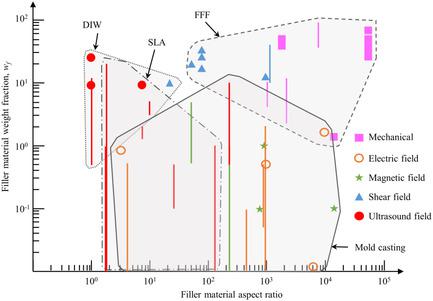当前位置:
X-MOL 学术
›
Adv. Eng. Mater.
›
论文详情
Our official English website, www.x-mol.net, welcomes your feedback! (Note: you will need to create a separate account there.)
Additive Manufacturing of Polymer Matrix Composite Materials with Aligned or Organized Filler Material: A Review
Advanced Engineering Materials ( IF 3.6 ) Pub Date : 2021-01-26 , DOI: 10.1002/adem.202001002 Karl Niendorf 1 , Bart Raeymaekers 1
Advanced Engineering Materials ( IF 3.6 ) Pub Date : 2021-01-26 , DOI: 10.1002/adem.202001002 Karl Niendorf 1 , Bart Raeymaekers 1
Affiliation

|
The ability to fabricate polymer matrix composite materials with continuous or discontinuous filler material, oriented in a user‐specified direction, enables implementing designer material properties, such as anisotropic mechanical, thermal, and electrical properties. Conventional fabrication methods rely on a mold, which limits specimen geometry and is difficult to implement. In contrast, additive manufacturing, including fused filament fabrication or fused deposition modeling, direct ink writing, or stereolithography, combined with a method to align filler material such as a mechanical force or an electric, magnetic, shear force, or ultrasound wave field, enables 3D printing polymer matrix composite material specimens with complex geometry and aligned filler material, without the need for a mold. Herein, we review the combinations of fabrication and filler material alignment methods used to fabricate polymer matrix composite materials, in terms of operating and design parameters including size, resolution, print speed, filler material alignment time, polymer matrix and filler material requirements, and filler manipulation requirements. The operating envelope of each fabrication method is described and their advantages, disadvantages, and limitations are discussed. Finally, different combinations of 3D printing and filler material alignment methods in the context of important engineering applications, such as structural materials, flexible electronics, and shape‐changing materials, are illustrated.
中文翻译:

对齐或组织填充材料的聚合物基复合材料的增材制造:综述
以用户指定的方向定向来制造具有连续或不连续填充材料的聚合物基复合材料的能力,可以实现设计人员的材料特性,例如各向异性的机械,热和电特性。常规的制造方法依赖于模具,该模具限制了样品的几何形状并且难以实施。相反,增材制造(包括熔融长丝制造或熔融沉积建模,直接墨水书写或立体光刻)与对齐填充材料(如机械力或电磁力,电磁力,剪切力或超声波场)的方法相结合,可以实现3D打印聚合物基质复合材料样品,具有复杂的几何形状和对齐的填充材料,无需模具。在此处,我们从操作和设计参数(包括尺寸,分辨率,印刷速度,填充材料对齐时间,聚合物基质和填充材料要求以及填充剂操作要求)方面回顾了用于制造聚合物基复合材料的制造方法和填充材料对齐方法的组合。描述了每种制造方法的工作范围,并讨论了它们的优缺点和局限性。最后,说明了重要工程应用中3D打印和填充材料对齐方法的不同组合,例如结构材料,柔性电子产品和形状可变的材料。分辨率,打印速度,填料对齐时间,聚合物基体和填料要求以及填料处理要求。描述了每种制造方法的工作范围,并讨论了它们的优缺点和局限性。最后,说明了重要工程应用中3D打印和填充材料对齐方法的不同组合,例如结构材料,柔性电子产品和可变形材料。分辨率,打印速度,填料对齐时间,聚合物基体和填料要求以及填料处理要求。描述了每种制造方法的工作范围,并讨论了它们的优缺点和局限性。最后,说明了重要工程应用中3D打印和填充材料对齐方法的不同组合,例如结构材料,柔性电子产品和可变形材料。
更新日期:2021-01-26
中文翻译:

对齐或组织填充材料的聚合物基复合材料的增材制造:综述
以用户指定的方向定向来制造具有连续或不连续填充材料的聚合物基复合材料的能力,可以实现设计人员的材料特性,例如各向异性的机械,热和电特性。常规的制造方法依赖于模具,该模具限制了样品的几何形状并且难以实施。相反,增材制造(包括熔融长丝制造或熔融沉积建模,直接墨水书写或立体光刻)与对齐填充材料(如机械力或电磁力,电磁力,剪切力或超声波场)的方法相结合,可以实现3D打印聚合物基质复合材料样品,具有复杂的几何形状和对齐的填充材料,无需模具。在此处,我们从操作和设计参数(包括尺寸,分辨率,印刷速度,填充材料对齐时间,聚合物基质和填充材料要求以及填充剂操作要求)方面回顾了用于制造聚合物基复合材料的制造方法和填充材料对齐方法的组合。描述了每种制造方法的工作范围,并讨论了它们的优缺点和局限性。最后,说明了重要工程应用中3D打印和填充材料对齐方法的不同组合,例如结构材料,柔性电子产品和形状可变的材料。分辨率,打印速度,填料对齐时间,聚合物基体和填料要求以及填料处理要求。描述了每种制造方法的工作范围,并讨论了它们的优缺点和局限性。最后,说明了重要工程应用中3D打印和填充材料对齐方法的不同组合,例如结构材料,柔性电子产品和可变形材料。分辨率,打印速度,填料对齐时间,聚合物基体和填料要求以及填料处理要求。描述了每种制造方法的工作范围,并讨论了它们的优缺点和局限性。最后,说明了重要工程应用中3D打印和填充材料对齐方法的不同组合,例如结构材料,柔性电子产品和可变形材料。


























 京公网安备 11010802027423号
京公网安备 11010802027423号